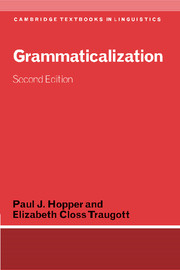Book contents
- Frontmatter
- Contents
- List of figures
- List of tables
- Preface and acknowledgments
- List of abbreviations
- 1 Some preliminaries
- 2 The history of grammaticalization
- 3 Mechanisms: reanalysis and analogy
- 4 Pragmatic factors
- 5 The hypothesis of unidirectionality
- 6 Clause-internal morphological changes
- 7 Grammaticalization across clauses
- 8 Grammaticalization in situations of extreme language contact
- 9 Summary and suggestions for further work
- Notes
- References
- Index of names
- Index of languages
- General index
4 - Pragmatic factors
Published online by Cambridge University Press: 05 June 2012
- Frontmatter
- Contents
- List of figures
- List of tables
- Preface and acknowledgments
- List of abbreviations
- 1 Some preliminaries
- 2 The history of grammaticalization
- 3 Mechanisms: reanalysis and analogy
- 4 Pragmatic factors
- 5 The hypothesis of unidirectionality
- 6 Clause-internal morphological changes
- 7 Grammaticalization across clauses
- 8 Grammaticalization in situations of extreme language contact
- 9 Summary and suggestions for further work
- Notes
- References
- Index of names
- Index of languages
- General index
Summary
Introduction
Although it is possible to describe change in terms of the operation of successive strategies of reanalysis (rule change) and analogy (rule generalization), the important question remains why these strategies come about — in other words, what enables the mechanisms we have outlined, most especially those involved in grammaticalization. It is tempting to think in terms of “causes” and even of “explanations” in the sense of “predictions.” However, the phenomena that give rise to language change are so complex that they will perhaps never be understood in enough detail for us to state precisely why a specific change occurred in the past or to predict when one will occur and if it does what it will be (Lass 1980). Rather than referring to “causes” or “explanations,” we speak more cautiously of motivations or enabling factors, understanding always that we are referring to potential and statistically preferred, not absolute, factors (see, among many others, Greenberg 1978b; Romaine 1982; Croft 2000; Maslova 2000).
As mentioned previously, among motivations for change three have been widely discussed in recent years. Of greatest interest within generative linguistics has been the role of language acquisition, especially child language acquisition. Sociolinguists, by contrast, have tended to focus attention on the role of communities and different types of contact within them. Of special interest to those working on grammaticalization has been the role of speakers and hearers negotiating meaning in communicative situations.
- Type
- Chapter
- Information
- Grammaticalization , pp. 71 - 98Publisher: Cambridge University PressPrint publication year: 2003

